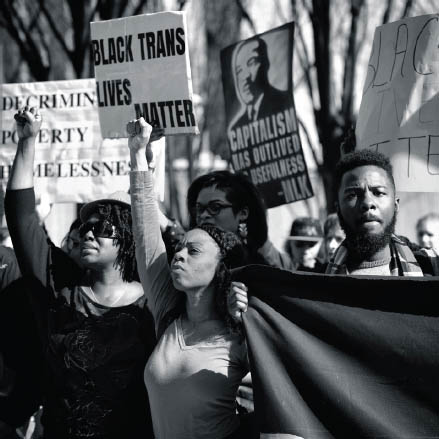

SHEILA PREE BRIGHT IS BOTH A PHOTOGRAPHER
AND AN URBAN ANTHROPOLOGIST.
She is an “ethnograph-photographer” who is a participant-observer in the communities that populate her images. Documenting histories and cultures of everyday life, Bright offers visual accounts of the ways in which ordinary people accomplish extraordinary things. The subjects of Bright’s images dare to challenge hegemonies, empower themselves, and define their place in the world as individuals representing a community. Bright does the same. While celebrating the agency of her subjects, the photographer confronts and interrogates the assumed validity of institutions that legitimate their own power while marginalizing the agency of others. Bright responds by authenticating grassroots knowledge and truth. In the world that she portrays, people act to produce their own realities, truth, and meaning. Her #1960Now series is the perfect example of this.

2015, #ReclaimMLKDay, Black Lives Matter disrupts MLK Day parades across the country, Atlanta, GA
In #1960Now, as in her 1960Who series of portraits, Bright has created images of the sometimes anonymous and often unsung heroes of grassroots social change, to construct an alternative lens on civil rights history and contemporary protest movements. This particular portfolio engages Black Lives Matter and the symbolic interaction that has shaped Black Lives protests as culture and ideology. Through images of mobilization, Bright visually articulates the structures of cultural knowledge through symbols of social consciousness that have meaning to multiple generations. Symbols of protests captured by photographs that reflect the meaning, truth, and realities of a culture become knowable through the signs and representations that Bright shares. Seconds split by the click of an aperture capture voices raised in prayer, chant, or song. Extended fists punctuate the sky in solidarity, and elevated protest signs give shape, form, and compositional movement to the photographic canvas, while expressing the voice and language of the unrecognized and unheard. Sheila Pree Bright gives her subjects language, agency, and recognition, while creating a subjective understanding of Black Lives Matter as a culture, an ideology, and a crusade.
Curator of Photography, Visual Culture, and Contemporary Political History at the Smithsonian National Museum of African American History and Culture

Along these lines, the symbolic interaction inherent in Bright’s photography positions the cultural and political perspectives of Black Lives Matter within the larger context of the Civil Rights Movement. This is evident in the photographer’s choice to title the series #1960Now. Protests in Ferguson and Baltimore, for example, some of which shifted from peace rallies to riots, raise questions today that are similar to those posed by commissions during the 1960s on America’s riots and civil disorder. The Kerner Commission, fifty years ago, drew conclusions that are shocking to consider now because they seem too familiar to us today. From Watts to New Brunswick, many riots of the period were sparked by confrontations with police officers. Reports also cited racial discrimination, economic injustice, and quality-of-life disparities as incubators for repressed resentment that eventually erupted in cities across the country.
Bright suggests similar issues in her photography. However, she focuses on solutions and on communities mobilized for peace, action, and change. One image taken in Atlanta, in particular, renders a crowded group of protesters, and to the far left are two women with their fists raised. Behind them are people carrying protest signs. The sign to the far right reads in large, handwritten letters, “Black Lives Matter.” Another sign declares “Black Trans Lives Matter.” Then two different signs speak directly to quality of life and economic justice: The first simply states “Discrimination, Poverty, Homelessness”; while the second features an image of Martin Luther King Jr. and his observation that “capitalism has outlived its usefulness.” The quote is taken from a letter that King wrote to his wife, Coretta Scott King, on July 18, 1952, when the couple had been dating for only a few months and refers specifically to King’s thoughts on collectivism and the social gospel.
More than ten years later, King would argue that the inhumanity of poverty was the root cause of the violent backlash in America’s cities, and until his assassination in 1968, the civil rights leader saw riots of the period as a consequence of legislatively supported racial discrimination that created economic disparities between White and Black communities. King maintained that peaceful but disruptive mobilization to force changes in government policies would be the only solution to civil unrest. With that in mind, the Baptist minister organized the Poor People’s Campaign. Today, we mobilize around similar issues through Black Lives Matter and other issue-specific protests.
Like other documentarians before her, Sheila Pree Bright has committed her art to social justice and change. She positions her photography as a public sphere in which viewers become a discursive part of an idioculture and movement. Each image serves as a photographic space of cultural exchange and symbolic interaction in which Black lives, Trans lives, and social justice matter. Within this sphere, not only are individuals as subject positions discursively produced, as part of a cultural dialectic, they shape and reshape the discourse and thus, their own subjectivity, through images that capture the traditions and ideas of generations from the 1960s to now and into the future.